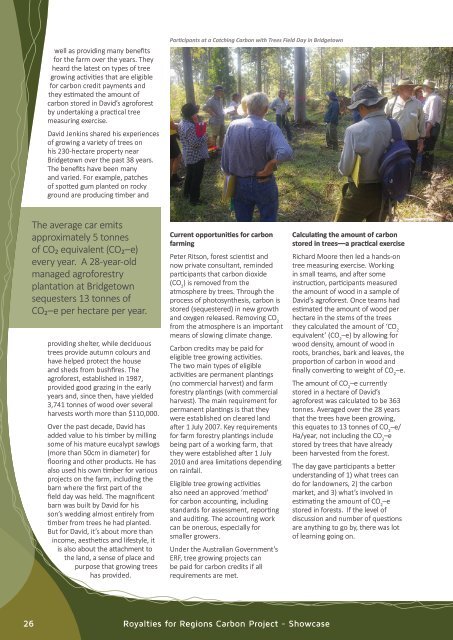Royalties for RegionS Carbon Project - showcase
R4R%20Carbon%20Magazine%20Aug16
R4R%20Carbon%20Magazine%20Aug16
Create successful ePaper yourself
Turn your PDF publications into a flip-book with our unique Google optimized e-Paper software.
well as providing many benefits<br />
<strong>for</strong> the farm over the years. They<br />
heard the latest on types of tree<br />
growing activities that are eligible<br />
<strong>for</strong> carbon credit payments and<br />
they estimated the amount of<br />
carbon stored in David’s agro<strong>for</strong>est<br />
by undertaking a practical tree<br />
measuring exercise.<br />
David Jenkins shared his experiences<br />
of growing a variety of trees on<br />
his 230-hectare property near<br />
Bridgetown over the past 38 years.<br />
The benefits have been many<br />
and varied. For example, patches<br />
of spotted gum planted on rocky<br />
ground are producing timber and<br />
Participants at a Catching <strong>Carbon</strong> with Trees Field Day in Bridgetown<br />
The average car emits<br />
approximately 5 tonnes<br />
of CO₂ equivalent (CO₂–e)<br />
every year. A 28-year-old<br />
managed agro<strong>for</strong>estry<br />
plantation at Bridgetown<br />
sequesters 13 tonnes of<br />
CO₂–e per hectare per year.<br />
providing shelter, while deciduous<br />
trees provide autumn colours and<br />
have helped protect the house<br />
and sheds from bushfires. The<br />
agro<strong>for</strong>est, established in 1987,<br />
provided good grazing in the early<br />
years and, since then, have yielded<br />
3,741 tonnes of wood over several<br />
harvests worth more than $110,000.<br />
Over the past decade, David has<br />
added value to his timber by milling<br />
some of his mature eucalypt sawlogs<br />
(more than 50cm in diameter) <strong>for</strong><br />
flooring and other products. He has<br />
also used his own timber <strong>for</strong> various<br />
projects on the farm, including the<br />
barn where the first part of the<br />
field day was held. The magnificent<br />
barn was built by David <strong>for</strong> his<br />
son’s wedding almost entirely from<br />
timber from trees he had planted.<br />
But <strong>for</strong> David, it’s about more than<br />
income, aesthetics and lifestyle, it<br />
is also about the attachment to<br />
the land, a sense of place and<br />
purpose that growing trees<br />
has provided.<br />
Current opportunities <strong>for</strong> carbon<br />
farming<br />
Peter Ritson, <strong>for</strong>est scientist and<br />
now private consultant, reminded<br />
participants that carbon dioxide<br />
(CO 2<br />
) is removed from the<br />
atmosphere by trees. Through the<br />
process of photosynthesis, carbon is<br />
stored (sequestered) in new growth<br />
and oxygen released. Removing CO 2<br />
from the atmosphere is an important<br />
means of slowing climate change.<br />
<strong>Carbon</strong> credits may be paid <strong>for</strong><br />
eligible tree growing activities.<br />
The two main types of eligible<br />
activities are permanent plantings<br />
(no commercial harvest) and farm<br />
<strong>for</strong>estry plantings (with commercial<br />
harvest). The main requirement <strong>for</strong><br />
permanent plantings is that they<br />
were established on cleared land<br />
after 1 July 2007. Key requirements<br />
<strong>for</strong> farm <strong>for</strong>estry plantings include<br />
being part of a working farm, that<br />
they were established after 1 July<br />
2010 and area limitations depending<br />
on rainfall.<br />
Eligible tree growing activities<br />
also need an approved ‘method’<br />
<strong>for</strong> carbon accounting, including<br />
standards <strong>for</strong> assessment, reporting<br />
and auditing. The accounting work<br />
can be onerous, especially <strong>for</strong><br />
smaller growers.<br />
Under the Australian Government’s<br />
ERF, tree growing projects can<br />
be paid <strong>for</strong> carbon credits if all<br />
requirements are met.<br />
Calculating the amount of carbon<br />
stored in trees—a practical exercise<br />
Richard Moore then led a hands-on<br />
tree measuring exercise. Working<br />
in small teams, and after some<br />
instruction, participants measured<br />
the amount of wood in a sample of<br />
David’s agro<strong>for</strong>est. Once teams had<br />
estimated the amount of wood per<br />
hectare in the stems of the trees<br />
they calculated the amount of ‘CO 2<br />
equivalent’ (CO 2<br />
–e) by allowing <strong>for</strong><br />
wood density, amount of wood in<br />
roots, branches, bark and leaves, the<br />
proportion of carbon in wood and<br />
finally converting to weight of CO 2<br />
–e.<br />
The amount of CO 2<br />
–e currently<br />
stored in a hectare of David’s<br />
agro<strong>for</strong>est was calculated to be 363<br />
tonnes. Averaged over the 28 years<br />
that the trees have been growing,<br />
this equates to 13 tonnes of CO 2<br />
–e/<br />
Ha/year, not including the CO 2<br />
–e<br />
stored by trees that have already<br />
been harvested from the <strong>for</strong>est.<br />
The day gave participants a better<br />
understanding of 1) what trees can<br />
do <strong>for</strong> landowners, 2) the carbon<br />
market, and 3) what’s involved in<br />
estimating the amount of CO 2<br />
–e<br />
stored in <strong>for</strong>ests. If the level of<br />
discussion and number of questions<br />
are anything to go by, there was lot<br />
of learning going on.<br />
26<br />
<strong>Royalties</strong> <strong>for</strong> Regions <strong>Carbon</strong> <strong>Project</strong> - Showcase


